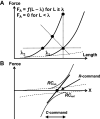Efference copy in kinesthetic perception: a copy of what is it?
- PMID: 33566734
- PMCID: PMC8282223
- DOI: 10.1152/jn.00545.2020
Efference copy in kinesthetic perception: a copy of what is it?
Abstract
A number of notions in the fields of motor control and kinesthetic perception have been used without clear definitions. In this review, we consider definitions for efference copy, percept, and sense of effort based on recent studies within the physical approach, which assumes that the neural control of movement is based on principles of parametric control and involves defining time-varying profiles of spatial referent coordinates for the effectors. The apparent redundancy in both motor and perceptual processes is reconsidered based on the principle of abundance. Abundance of efferent and afferent signals is viewed as the means of stabilizing both salient action characteristics and salient percepts formalized as stable manifolds in high-dimensional spaces of relevant elemental variables. This theoretical scheme has led recently to a number of novel predictions and findings. These include, in particular, lower accuracy in perception of variables produced by elements involved in a multielement task compared with the same elements in single-element tasks, dissociation between motor and perceptual effects of muscle coactivation, force illusions induced by muscle vibration, and errors in perception of unintentional drifts in performance. Taken together, these results suggest that participation of efferent signals in perception frequently involves distorted copies of actual neural commands, particularly those to antagonist muscles. Sense of effort is associated with such distorted efferent signals. Distortions in efference copy happen spontaneously and can also be caused by changes in sensory signals, e.g., those produced by muscle vibration.
Keywords: coactivation; force matching; kinesthetic perception; referent coordinate; sense of effort.
Conflict of interest statement
No conflicts of interest, financial or otherwise, are declared by the author.
Figures










Similar articles
-
Stability of Kinesthetic Perception in Efferent-Afferent Spaces: The Concept of Iso-perceptual Manifold.Neuroscience. 2018 Feb 21;372:97-113. doi: 10.1016/j.neuroscience.2017.12.018. Epub 2017 Dec 23. Neuroscience. 2018. PMID: 29277305 Free PMC article.
-
Production and Perception of Intentional and Unintentional Actions.J Hum Kinet. 2021 Jan 29;76:51-66. doi: 10.2478/hukin-2020-0086. eCollection 2021 Jan. J Hum Kinet. 2021. PMID: 33603924 Free PMC article.
-
The control and perception of antagonist muscle action.Exp Brain Res. 2023 Jan;241(1):1-12. doi: 10.1007/s00221-022-06498-1. Epub 2022 Oct 30. Exp Brain Res. 2023. PMID: 36309879 Review.
-
Muscular responses appear to be associated with existence of kinesthetic perception during combination of tendon co-vibration and motor imagery.Exp Brain Res. 2017 Nov;235(11):3417-3425. doi: 10.1007/s00221-017-5057-6. Epub 2017 Aug 19. Exp Brain Res. 2017. PMID: 28823036
-
Active sensing without efference copy: referent control of perception.J Neurophysiol. 2016 Sep 1;116(3):960-76. doi: 10.1152/jn.00016.2016. Epub 2016 Jun 15. J Neurophysiol. 2016. PMID: 27306668 Free PMC article. Review.
Cited by
-
Understanding and Synergy: A Single Concept at Different Levels of Analysis?Front Syst Neurosci. 2021 Nov 18;15:735406. doi: 10.3389/fnsys.2021.735406. eCollection 2021. Front Syst Neurosci. 2021. PMID: 34867220 Free PMC article. Review.
-
Force drifts and matching errors in the lower extremities: implications for the control and perception of foot force.Exp Brain Res. 2024 Dec 31;243(1):37. doi: 10.1007/s00221-024-06990-w. Exp Brain Res. 2024. PMID: 39739043
-
Error-related brain state analysis using electroencephalography in conjunction with functional near-infrared spectroscopy during a complex surgical motor task.Brain Inform. 2022 Dec 9;9(1):29. doi: 10.1186/s40708-022-00179-z. Brain Inform. 2022. PMID: 36484977 Free PMC article.
-
Proprioception: A New Era Set in Motion by Emerging Genetic and Bionic Strategies?Annu Rev Physiol. 2023 Feb 10;85:1-24. doi: 10.1146/annurev-physiol-040122-081302. Epub 2022 Nov 18. Annu Rev Physiol. 2023. PMID: 36400128 Free PMC article. Review.
-
Layer 6 corticocortical neurons are a major route for intra- and interhemispheric feedback.Elife. 2025 Mar 28;13:RP100478. doi: 10.7554/eLife.100478. Elife. 2025. PMID: 40153297 Free PMC article.
References
-
- Von Holst E, Mittelstaedt H. The reafference principle. In: The Behavioral Physiology of Animals and Man. The Collected Papers of Erich von Holst, translated by Martin R.Coral Gables, FL: University of Miami Press, pp. 139–173, 1950/1973.
Publication types
MeSH terms
Grants and funding
LinkOut - more resources
Full Text Sources
Other Literature Sources

